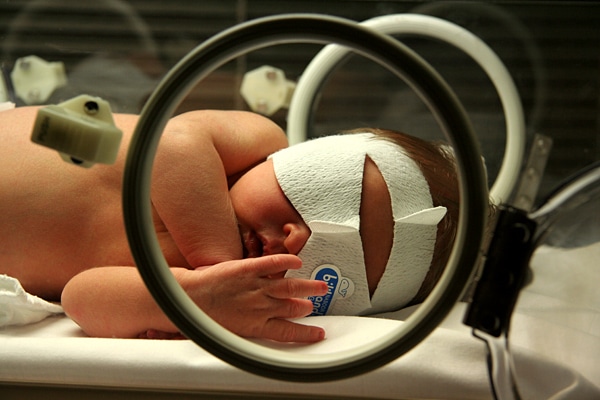With infant jaundice, many moms worry that there is something wrong with her breast milk or that she doesn’t have enough. When bilirubin levels are high parents may be told to supplement with formula or to stop breastfeeding altogether. This article will help explain newborn jaundice, its different causes and why moms should continue breastfeeding their jaundiced baby.
Newborn Jaundice
Jaundice is a very common condition for newborn babies. Jaundice is a yellowing of the skin due to a build-up of excess bilirubin. Bilirubin is a product of red blood cells that break down during the transition to a higher oxygen environment (Mannel, Martins & Walker, 2013). Typically, bilirubin conjugates in the liver and passes from the bile duct to the small intestine, where it is then excreted through the infant’s stool (meconium).
While high levels of bilirubin is associated with acute bilirubin encephalopathy or kernicterus, mild to moderate levels can help protect cells against oxidative stress (Newman, 2017). Routine bilirubin screening 24 hours after birth has been implemented within Canada and the United States. Bilirubin levels are plotted on a graph according to an infant’s age in hours and it is determined whether the infant is at high, intermediate or low risk for complications. Bilitool.org is a great tool for health care professionals as it reduces risk of errors when plotting a newborn bilirubin level on the risk nomogram. Treatments such as phototherapy or exchange transfusion are initiated before bilirubin levels become high enough to cause neurological damage.
It is important to note that in the United States it costs $9,191,352 to perform TcB tests on every newborn in order to prevent one case of kernicterus (Surech & Clark, 2004). These costs could be drastically reduced by providing breastfeeding support and close follow-up to all mother-infant dyads and only screening infants who are at increased risk of developing complications from jaundice including premature and unwell infants.
Types of Newborn Jaundice
Breastfeeding Jaundice
“Breastfeeding jaundice” occurs when a newborn appears jaundiced with minimal urine/stool output, appears sleepy and has had excessive weight loss. This type of newborn jaundice is caused by bilirubin recirculating due to ineffective feeding and delayed stooling.
This term can be misleading for new parents, and can perpetuate the common misconception of perceived insufficient milk supply. This type of jaundice relates to the amount of milk transferred to the baby due to ineffective feeding rather than the quantity or quality of breast milk the mother has.
These infants need immediate follow-up with their primary care provider and referral to an IBCLC (International Board Certified Lactation Consultant). See “treatment” section below for more information.
Breast Milk Jaundice
While “breastfeeding jaundice” is related to the amount of milk transferred by the baby, breast milk jaundice occurs when a healthy, breastfed baby is feeding and gaining well, yet has persistently elevated bilirubin levels. The cause of breast milk jaundice is not well understood, and tends to have a genetic component. It typically presents around 1 week of age and gradually declines over 3-12 weeks (Mannel et al., 2013).
Some primary care providers advise mothers to stop breastfeeding for 24-48 hours and to begin formula feeding in order to diagnose breast milk jaundice. If the bilirubin decreases during this period of time, the infant presumably has breast milk jaundice.
However, this strategy is outdated and is not considered necessary by most experts (Preer & Phillip, 2011). Jack Newman questions whether breast milk jaundice even exists or rather is just a normal extension of physiologic jaundice (Newman & Pitman, 2009). It is important that primary care providers consider the negative impact to the breastfeeding relationship in relation to what benefit a diagnosis would have for the infant.
Rather than interrupting breastfeeding, the provider should consider ruling out all other pathological causes of jaundice, and following up closely until the bilirubin level begin to trend downward. Breast milk jaundice rarely requires intervention.
Physiologic Jaundice
All newborns experience a physiologic rise in bilirubin, but not all result in a high enough level to cause a jaundiced appearance (Mannel et al., 2013). It usually starts around 24-72 hours of age and resolves within a week without intervention. As long as bilirubin levels are less than 18 mg/dl, the infant is feeding and stooling appropriately and are otherwise healthy, physiologic newborn jaundice will resolve on it’s own (Ullah, Rahman, & Hedayati, 2016).
Pathologic Jaundice
Pathologic jaundice is jaundice that is caused by a disease process. It usually presents with high bilirubin levels before 24 hours of age that rise quickly or the jaundiced infant is over 3 weeks of age and is not thriving. Pathologic jaundice requires immediate medical intervention.
Some common causes of pathological newborn jaundice include:
- Galactosemia – a metabolic disease that causes infants to be unable to metabolise lactose. This is a very rare condition and would require the infant to be placed on lactose-free formula.
- Glucose-6-phosphatase deficiency – a breakdown of red blood cells when babies are exposed to certain toxins or drugs (Newman & Pitman, 2009)
- Hypothyroidism – underactive thyroid, baby will need to be treated with thyroid medication
- Urinary tract infection
Hemolytic Jaundice
Jaundice caused by blood type incompatibilities between mom and baby. For more information see: Hemolytic Disease of the Newborn.
Treatment
“Breastfeeding jaundice” can be easily avoided or corrected without formula supplementation by providing early breastfeeding support by an IBCLC. When the infant demonstrates signs of breastfeeding jaundice, the mother-baby dyad should be referred immediately to an expert in breastfeeding to develop a plan of care with the mother to:
- Increase infant caloric intake
- Establish effective breastfeeding
- Initiate supplementation (mother’s breast milk, donor breast milk or formula as last choice
- Stimulate milk supply (Mannel et al., 2013)
The frequent recommendation for parents to start supplementing with formula, usually with no consideration to breast stimulation to regulate supply, can create a host of breastfeeding difficulties later on. These include flow preference, latching difficulties, engorgement, plugged ducts, mastitis and decreased milk supply.
In addition, colostrum acts as a laxative and increases the amount of bilirubin excreted through the meconium. Instead of immediately offering formula as a supplement of choice, the mother should be supported in her breastfeeding journey with manual expression/pumping techniques, supplementing at the breast, assessing for oral restrictions and increasing breast milk transfer.
In addition to breastfeeding support, infants who have severely elevated bilirubin levels may require phototherapy or in worst-case scenarios an exchange transfusion.
Phototherapy
Phototherapy lights create photoisomers of bilirubin which are more easily excreted through infant stool. It can be given through a bili-light placed over an undressed baby with eyes covered in an isolette or through a fiber-optic blanket (bili-blanket) placed directly on the infant’s back. Sometimes “double phototherapy” is used, which is a combination of the two.
Exchange Transfusion
An exchange transfusion, while rarely ever needed, may be used if bilirubin levels remain dangerously high and phototherapy has been ineffective at lowering levels. It sometimes is required with preterm infants or infants with severe hemolytic disease (Mannel et al., 2013). With exchange transfusion, a small amount of the infant’s blood are withdrawn through an umbilical vein catheter or intravenous line, and replaced with donor blood (Dysart, 2018).
Conclusion
In conclusion, while newborn jaundice can be worrying for parents and health care providers, it is important to remember that it is a very common physiological condition, and that bilirubin at low to moderate levels functions as an antioxidant. It is important for infants with jaundice to be monitored closely by their primary care provider, and to rule out pathological causes. If there is a concern about breastfeeding or breast milk jaundice, they should be referred to a lactation consultant (IBCLC). Only in the rare cases of galactosemia should breastfeeding be stopped, and all other causes of jaundice should be ruled out prior.
References
Dysart, K. C. (2018). Neonatal hyperbilirubinemia (jaundice in neonates). Retrieved from https://www.merckmanuals.com/en-ca/professional/pediatrics/metabolic,-electrolyte,-and-toxic-disorders-in-neonates/neonatal-hyperbilirubinemia
Mannel, R., Martens, P. J., & Walker, M. (2013). Core Cirriculum for Lactation Consultant Practice (3rd Ed.). Jones & Bartlett Learning: Burlington, MA.
Newman, J. (2017). Breastfeeding, bilirubin and jaundice. Retrieved from https://ibconline.ca/breastfeeding-bilirubin-and-jaundice/
Newman, J. & Pitman, T. (2009). Dr. Jack Newman’s Guide to Breastfeeding (2nd Ed.). HarperCollins Publishers: Toronto, ON.
Preer, G. L., & Phillip, B. L. (2011). Understanding and managing breast milk jaundice. Archives of Disease in Childhood: Fetal and Neonatal Edition, 96(6): 461-466.
Surech, G. K. & Clark, R. E. (2004). Cost-effectiveness of strateies that are intended to prevent kernicterus in newborn infants. Pediatrics, 114, 917-924.
Ullah, S., Rahman, K., & Hedayati, M. (2016). Hyperbilirubinemia in neonates: Types, causes, clinical examinations, preventive measures and treatments: A narrative review article. Iranian Journal of Public Health, 45(5): 558-568. Retrieved from https://www.ncbi.nlm.nih.gov/pmc/articles/PMC4935699




0 Comments
Trackbacks/Pingbacks